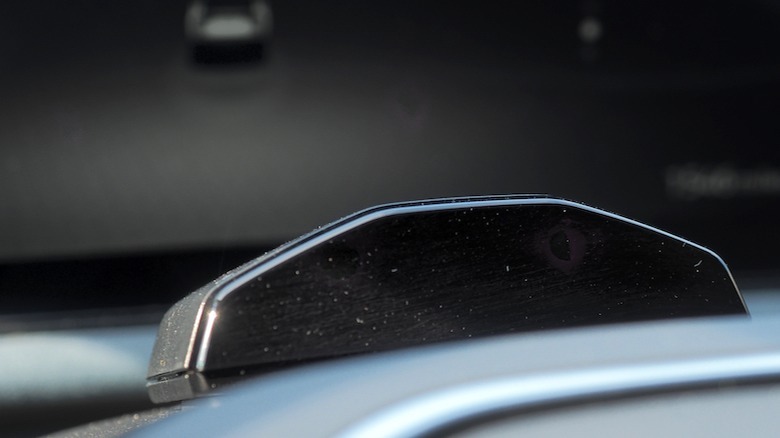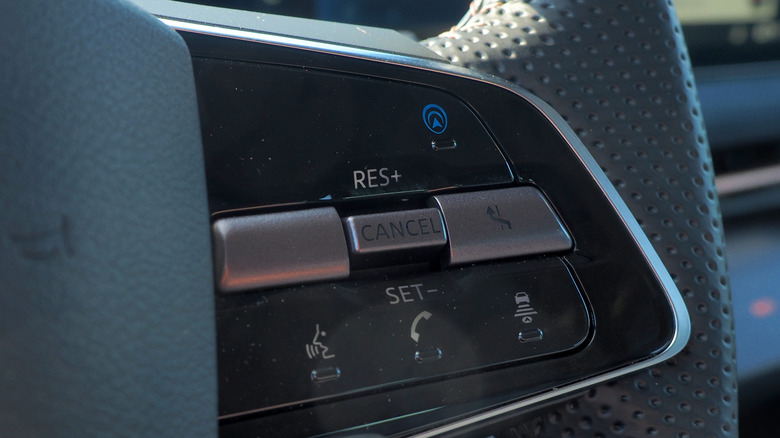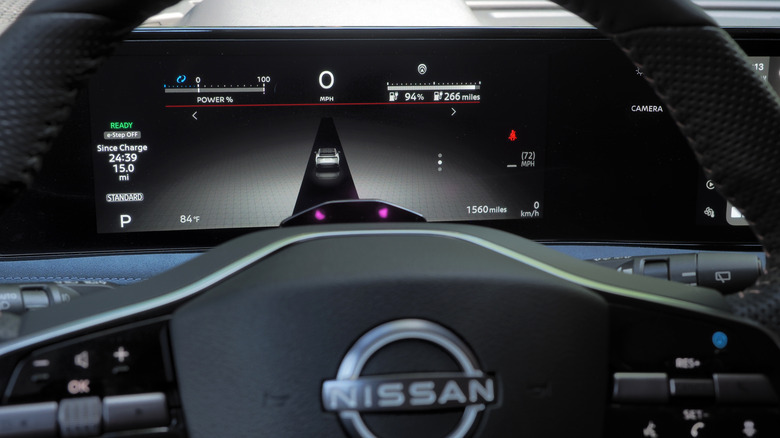Nissan's Hands-Free ProPilot Assist Is Good, But One Change Would Make It So Much Better
You can't buy a true self-driving car, but you can get some assistance on the more uninspiring stretches of your next road trip. That's what systems like Nissan ProPilot Assist 2 offer — assuming, that is, you're on a compatible stretch of highway — a combination of adaptive cruise control, lane-keeping, and hands-free attention monitoring. As with rival systems like GM Super Cruise and Ford BlueCruise, the goal is to remove some of the driver headache, though not the responsibility.
Like the name suggests, this second-gen version builds on Nissan's more broadly-available ProPilot Assist. That's a hands-on system — your hands need to be detected physically on the steering wheel while it's active — and combines adaptable speed according to the vehicle ahead, and lane-centering.
ProPilot Assist 2.0 added a camera mounted on the steering column, an alternative way to track the driver's attention by watching where they're looking. While there are still steering wheel sensors, if the driver looks away from the road ahead for more than a passing glance, the system will complain and, eventually, deactivate. Currently offered on vehicles like the Nissan Ariya EV and the upcoming 2025 Infiniti QX80, this 2.x version of the system has some clear advantages — and some lingering drawbacks.
No, this doesn't make your Nissan autonomous
Like Super Cruise, BlueCruise, Tesla Autopilot, and other systems, Nissan ProPilot Assist 2.0 (on the Ariya; 2.1 on the QX50) is a Level 2 driver-assistance technology. That means — according to the generally-accepted levels of driving automation, as defined by the SAE — that, while the car is helping with a combination of steering and speed control, the human at the wheel is still responsible overall. That's at odds with a Level 3 system, where when it's engaged the human at the wheel isn't driving (but must be prepared to take over control again when requested), or a Level 4/5 system, where no human control would ever be required.
We're a long way from that, with Level 2 approaches like ProPilot Assist 2.0. "You are driving whenever these driver support features are engaged – even if your feet are off the pedals and you are not steering," SEA standard J3016 makes clear. "You must constantly supervise these support features; you must steer, brake or accelerate as needed to maintain safety."
While not turning your Nissan into a self-driving car, that's not to say ProPilot Assist 2.0 isn't useful. It's just about knowing when, and where, the system can be relied upon, and what limits currently constrain it.
It only works if the maps are there
Like most other such systems, Nissan's relies on more detailed mapping than is usually present for in-car navigation. That means lane-level accuracy so that, together with a precision GPS sensor, cameras, and other sensing technology, ProPilot Assist 2.0 knows where on the highway, exactly, the vehicle is.
The downside to that approach is that it requires map data, and that's not a one-time-and-done endeavor. Nissan delivers periodic updates via the car's cellular connection, taking into account changes in the road layout, periods of maintenance, and other adjustments. Checking the coverage map, it was obvious that some of the major highways around me still had non-compatible stretches, despite my knowing that the road work there had been completed some time back.
As we've seen with Super Cruise and Ford BlueCruise, a fairly conservative approach means there'll be times Nissan's system demands the driver retake steering and speed control, because it can't be sure of the road ahead.
That request is made through the driver display. There's a small steering wheel icon, which turns green when the system is available and blue when it's active. A smaller blue lane-change graphic appears below that wheel when you can activate that feature. The currently-detected cars around you are shown in a dynamic road graphic, and a large red wheel flashes up if you need to retake steering control.
Hands back on the wheel if you want to change lane
Tap the turn signal, and ProPilot Assist 2.0 will help with a lane-change. As you'd expect, it scans the adjacent lane for existing or approaching traffic, before moving across. Your hands need to be — lightly, recognized by capacitive touch sensors — in contact for the wheel during the process, with a message flashing up on the driver's display when it's okay to remove them again.
ProPilot Assist 2.0 can automatically offer to begin the lane change process, if it finds itself stuck behind lower-speed traffic. That happens when there's roughly a 10 mph delta between the speed you've set the system to, and the current pace. At that point, and assuming the lane to your left is clear, you can press the lane-change button on the steering wheel, and ProPilot Assist 2.0 will attempt to make a safe maneuver across.
Unlike, say, the latest enhanced versions of Super Cruise on models like the GMC Sierra, Nissan's system won't make a lane change automatically: it always waits for the driver to confirm, first. Nor will it move back across — either automatically or with the dedicated lane-change button — to the right, once you've passed the slower traffic. For that, you need to tap the turn signal yourself. Often, I found myself hitting the steering wheel button and wondering why the car wasn't changing lanes, when I should've been tapping the stalk.
It's smarter if it knows where you're going
If you've programmed a destination into the Nissan navigation system — the native one, not through Apple CarPlay or Android Auto smartphone projection — then ProPilot Assist 2.0 can also do route assistance. That includes flagging the lane you need to be in, according to upcoming highway turns and off-ramps. Again, those specific maneuvers are all only undertaken when the driver presses the button or taps the stalk, and follows the relevant hands-on instructions communicated through the display.
In action, Nissan's system is a very cautious driver. Adaptive cruise control acceleration is on the careful side, and it's positively conservative when it comes to changing lanes. On the one hand, that's reassuring: yanking the wheel like an overconfident learner driver wouldn't exactly help you build rapport with the car. At the same time, though, there were definitely gaps in traffic that I felt I could've safely taken advantage of, had I been handling the maneuver myself, but which the Nissan decided not to exploit.
There's no way of tuning that aggressiveness (though, like with regular adaptive cruise control, ProPilot Assist 2.0 will allow you to set your maximum speed to higher than the posted limit of the highway you're on). As I've found with other systems, then, Nissan's has a sweet spot of usefulness that closes up before rush hour and other, more congested periods. Then, the car is just too tentative around more eager human drivers.
Good, but it could be so much better
As we've seen before, not all hands-off driver assistance systems are quite at the same functionality point, even if they all count as Level 2. GM Super Cruise's ability to automatically move around slower traffic can be shockingly disconcerting at first, but I quickly got used to it on a long, boring highway trip. In contrast, Nissan's tech feels more akin to different assistance systems more patchily interconnected: having to return your hands to the wheel during a lane-change, for instance, leaves it less cohesive an experience than rivals which can do that entirely hands-free.
Just as new road coverage can be added over time, though, so can — in theory — Nissan add new talents to ProPilot Assist 2.0. Most pressing, though, is expanding the compatible road network, something General Motors and Ford have a head start on. Back in February 2024, for example, GM expanded Super Cruise to around 750,000 miles across the U.S. and Canada, including many minor highways. Nissan currently has a fraction of the coverage.
Pro Pilot Assist 2.0 isn't going to revolutionize every journey, then, but neither do its counterparts at other automakers. What would arguably make the biggest difference — and potentially help Nissan distinguish itself from more technically-capable rivals — would be adding the system to cheaper trims. While the Ariya starts at $39,590, for instance, hands-free functionality is only offered on the most expensive Empower+ grade (from $47,690), keeping it out of the hands of many. If we're really going to push from Level 2 to higher automation, it'll take drivers knowing what technology is out there, and how it can potentially improve their driving experience.







